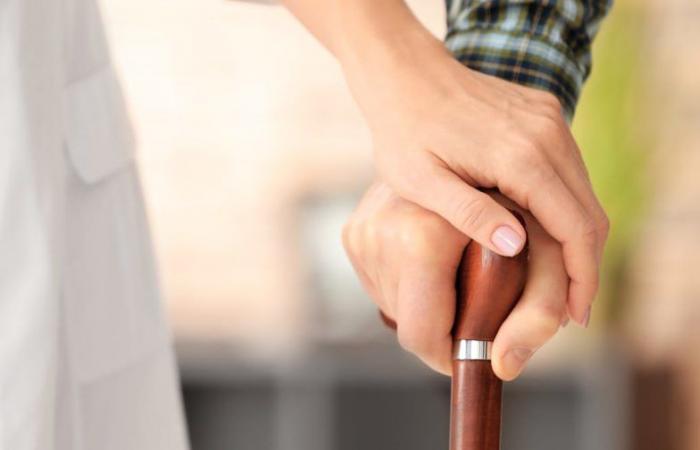In many diseases of genetic origin, not all patients who have the same mutation in their DNA develop the same symptoms. This is particularly the case for type R2 limb-girdle myopathy.
This disease, which affects the muscles of the shoulders and pelvis, begins in some patients at a very young age, while others will not experience symptoms until very late. While most people will lose the ability to walk, in rare cases the disease will never reach that stage.
To develop a treatment for this still incurable pathology, from which I myself suffer, it is important to understand the mechanisms developed by these “atypical” patients. This is the objective of my thesis, carried out within the research team of researcher Xavier Nissan, specialist in neuromuscular diseases. Our results made it possible to identify a possible explanation.
What is limb-girdle muscular dystrophy type R2?
Myopathies are conditions that result in poor muscle function. Symptoms are muscle weakening, pain, cramps and reduced mobility. There are different forms of myopathy: while the majority comes from genetic anomalies transmitted by parents, others can be caused by a dysfunction of the immune system, infections, or even by certain medications.
To date, more than 200 myopathies have been identified, the consequences of which are more or less severe. Duchenne muscular dystrophy is the best known and most common in children. It affects every muscle in the body, including those in the arms and legs, as well as the heart and the diaphragm, which is essential for breathing.
Limb-girdle muscular dystrophy type R2 is a muscle disease that causes weakening of the so-called “limb-girdle” muscles, i.e. the muscles of the shoulder girdle (muscles of the shoulders) and the pelvic girdle (muscles of the pelvis). This rare genetic disease affects approximately 1.63 people in 100,000. In the majority of cases, the heart and respiratory muscles are not affected, and life expectancy is not reduced.
Most patients with type R2 limb-girdle muscular dystrophy will only show the first symptoms in early adulthood, after a so-called “silent” phase. The first symptoms are muscle weakness, difficulty running or climbing stairs. The progression of the disease is usually slow, with progressive muscle weakening, until the patient is confined to a wheelchair.
Surprisingly, some patients do not develop the first symptoms until around the age of 60. In these patients, certain muscles and certain cells will be able to protect themselves from the disease.
To understand why, we need to be able to study the disease in the laboratory. To do this, we use stem cells.
Stem cells, an essential tool
Stem cells are very special cells: they are not only capable of multiplying infinitely, but also of transforming into any of the types of specialized cells that exist in the human body. These capabilities are very important for the study of genetic diseases and the development of treatments.
The Stem Cell Institute for the Treatment and Study of Monogenic Diseases (I-Stem), where I am doing my PhD, focuses on using induced pluripotent stem (ips) cells to understand and treat rare genetic diseases. These ips cells are created by reprogramming differentiated adult cells, such as skin cells, to return them to their stem cell state.
By using stem cells derived from myopathy patients, we are now able to reproduce the characteristics of the disease in the laboratory, providing a highly personalized disease model.
A question of genes?
Recently, a team of clinicians from La Pitié-Salpêtrière hospital conducted a retrospective study on a cohort of patients affected late by the disease. One of the questions that arises is: how did the bodies of these patients manage to fight the disease all these years?
To try to answer this, our team decided to compare the level of gene expression in late-onset patients to the level of gene expression of earlier-onset patients. This study was carried out on 15 muscle biopsies from patients. The results we obtained revealed that several genes are expressed differently between these two categories of patients.
Thanks to our induced pluripotent stem cells from patients, we are currently evaluating the impact of these genes on the disease: they allow us to study the effects of gene deregulation. The idea is to observe whether we improve or worsen the pathology by removing or overexpressing one of these genes directly on our “diseased” cells.
Thanks to this approach, my two and a half years of research allowed me to put my finger on a potential compensation mechanism in patients who develop the disease late.
A question of autophagy?
All patients in whom the disease developed late had higher levels of autophagy. This is the mechanism by which cells eliminate waste and toxins, while contributing to their own repair.
Concretely, the waste present in the cell is gathered in a vesicle, the autophagosome. This merges with another vesicle containing enzymes capable of digesting the contents of the autophagosome. The debris can then be used to manufacture new molecules or energy, thus helping the cell to stay healthy.
Autophagy has an essential role in the organism’s adaptation to difficult conditions. In conditions of stress or caloric restriction, it adapts to regulate the availability of carbohydrates, lipids and nucleic acids, and boosts our immune system. Autophagy can also enhance the degradation of various bacteria and viruses and play a protective role in many infectious diseases.
With age, the efficiency of the autophagy process declines, contributing to the accumulation of damaged proteins in cells and an increase in susceptibility to age-related diseases, such as degenerative diseases (such as Alzheimer’s and Parkinson’s diseases), cardiovascular diseases, or muscle degeneration. Conversely, the induction of autophagy promotes longevity in Drosophila, the nematode Caenorhabditis elegans or even the mouse.
In addition to cleaning up debris, autophagy also helps repair damaged cell membranes. All these vesicles bring new, healthy parts of membranes and help cells repair themselves. And that’s a good thing, because in type R2 limb-girdle muscular dystrophy, the muscles are no longer able to repair themselves, which impacts their function. It was following these observations that the hypothesis was born that higher levels of autophagy could help compensate for the disease and delay the development of the first symptoms.
New treatment options?
How can autophagy help scientists in their quest to find effective treatments for incurable muscle diseases? The answer lies in molecules that can stimulate autophagy. These “autophagy inducers” can help muscle cells clear out damaged proteins, toxic aggregates, and other cellular waste that contribute to disease progression. And thus, help them repair themselves better.
This observation applies to several incurable muscle diseases. For example, urolithin A and rapamycin, both inducers of autophagy, improve muscle function in Duchenne muscular dystrophy. The activation of autophagy helps muscle regeneration and acts on sarcopenia, responsible for the progressive and generalized decline in muscle mass during aging.
In addition, some natural substances can boost autophagy. This is the case, for example, of resveratrol, present in grapes, of curcumin from turmeric, of tomatidine found in tomatoes or of cucurbitacin from cucumbers…
Based on these different observations, our team decided to test a panel of molecules known to activate autophagy on our cellular models in the laboratory. Some of them proved to be very effective in the laboratory, and in particular helped protect the membrane of diseased muscle cells.
A small downside, however: all these molecules were tested at much higher concentrations than those found naturally in the products mentioned above. But this is a first step. Additional research is underway to fully understand the mechanism of action of these molecules in this pathology and to identify the most effective compound in order to then test it in vivo.






